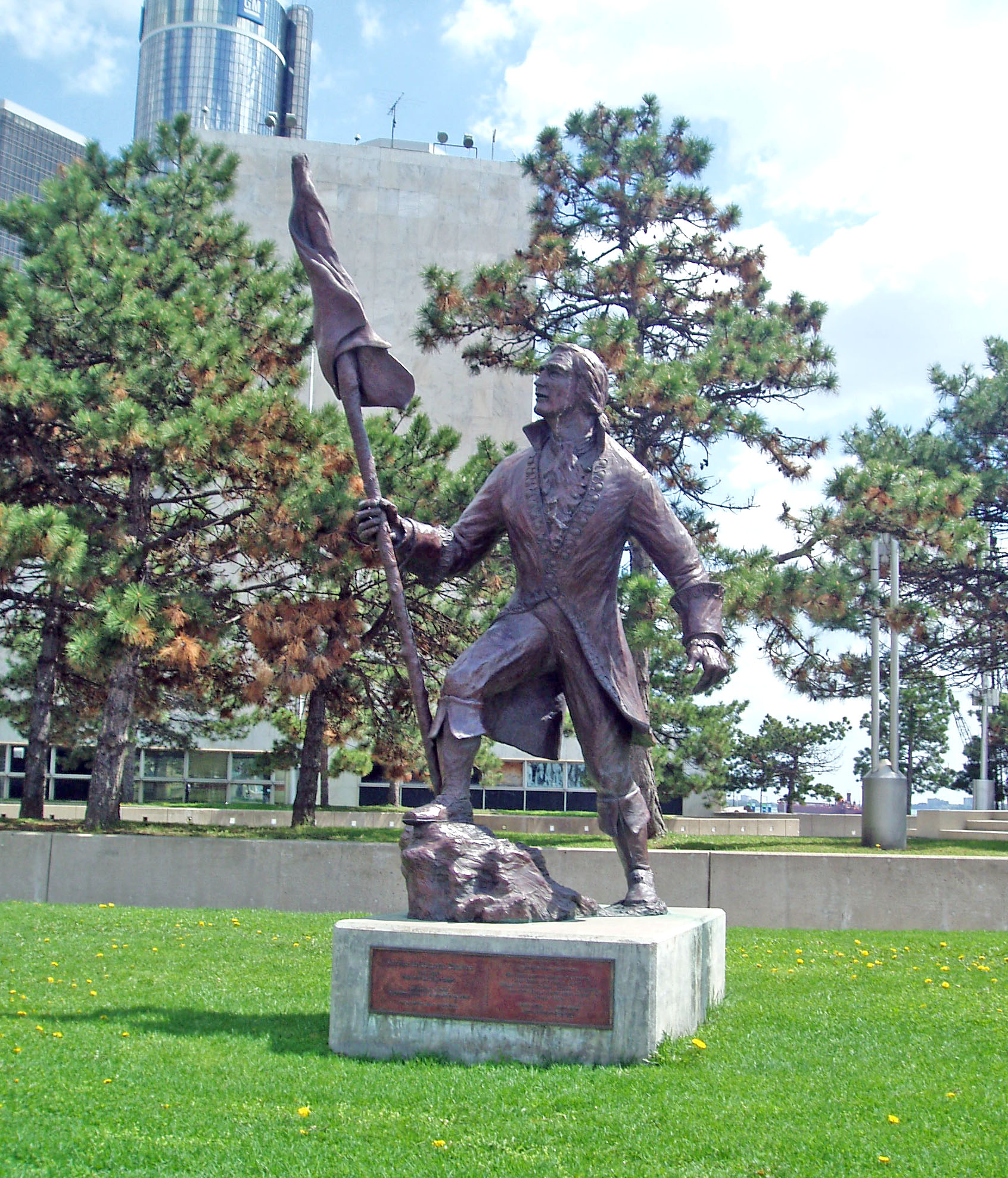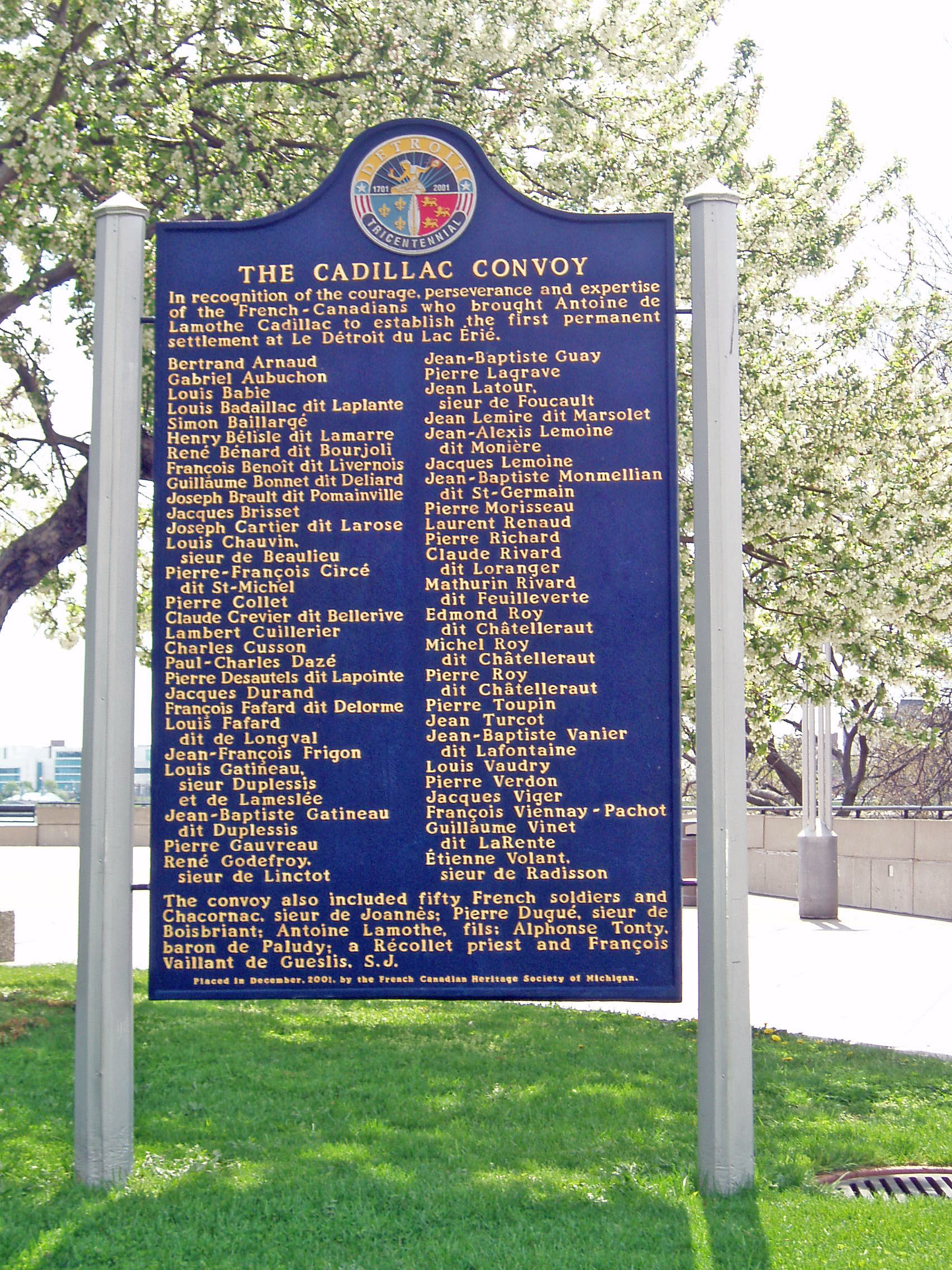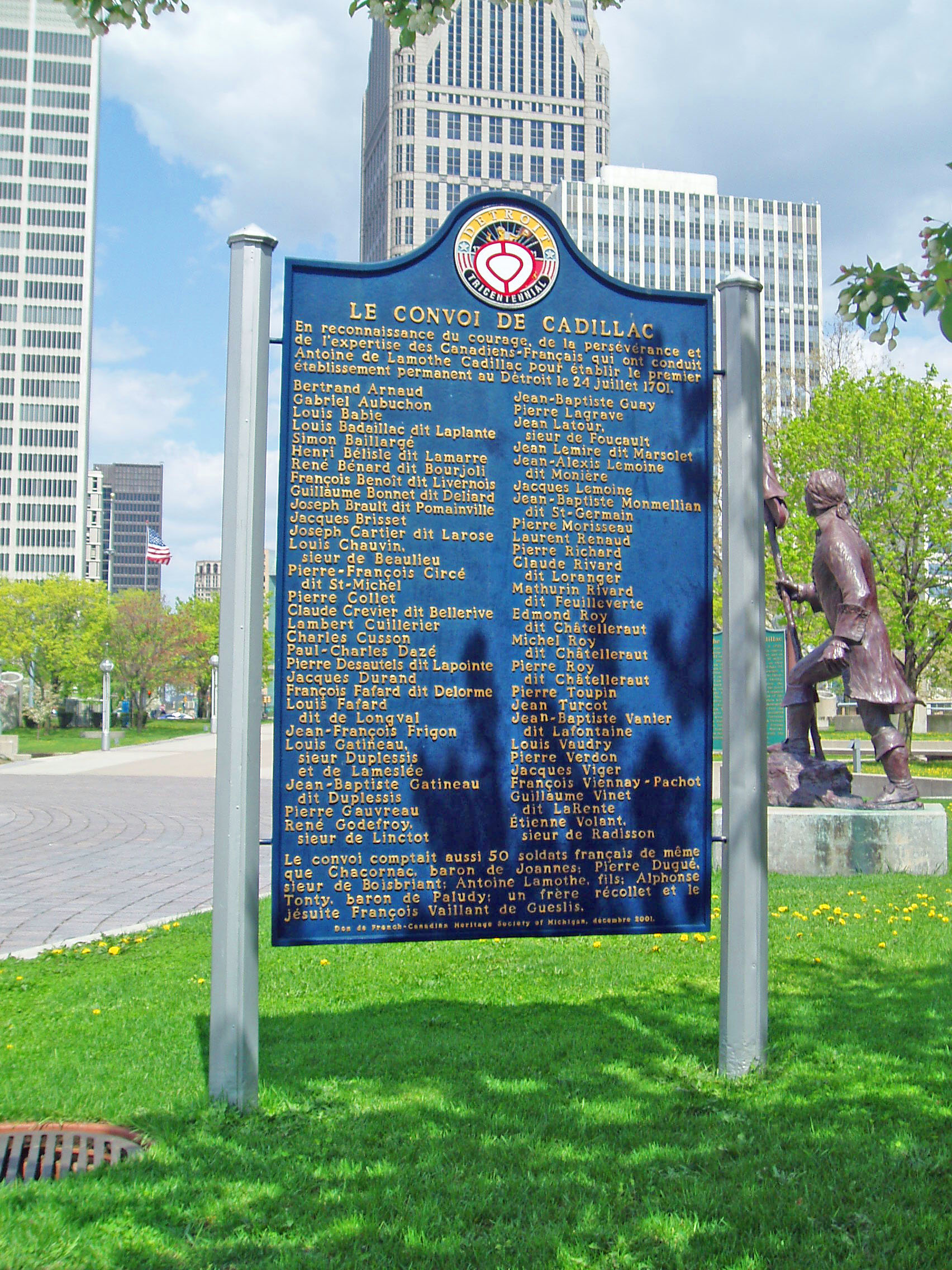
Antoine de la Mothe Cadillac Statue
Hart Plaza
The founder of Detroit, shown in this sculpture when he arrived at this point, was born Antoine Laumet in Saint Nicolas de la Grave in the Tarn et Garonne department in the Midi Pyrenées region of France. His father was a lawyer and, at one point, appointed to serve as a judge. So far as I know, no professional historian has written a comprehensive biography of Cadillac, so there is much that remains ambiguous about him. I have seen reports that Cadillac and Madam Cadillac had as few as seven or as many as 13 children. There may be extensive written materials from and about Cadillac in French archives but apparently no one has ransacked them recently. When you read descriptions of Cadillac, you will find many discrepancies in dates and different interpretations of his motives.
 Cadillac was apparently educated at a Jesuit School in France, and then, as a late teenager, enrolled in a school that trained military officers. Presumably, he joined the military when he was about age 20. In 1683, he got to Port Royal in present-day Nova Scotia. He may have been sent there by the French military or he may have gone there on his own, although it was not easy to migrate away from France in that era. Once in French North America, he supported himself working on sailing ships, perhaps moving up the ranks to become a captain. Some think that he was a trader who sailed along the coast of Arcadia and into the St. Lawrence. Others presume that he was a buccaneer who profited from relieving British ships of their cargo. At some point, he entered into business collaboration with a Québec merchant, Denis Guyon. I presume that his ships were trading along the coast of North America, so he became very familiar with harbors from Nova Scotia south.
Cadillac was apparently educated at a Jesuit School in France, and then, as a late teenager, enrolled in a school that trained military officers. Presumably, he joined the military when he was about age 20. In 1683, he got to Port Royal in present-day Nova Scotia. He may have been sent there by the French military or he may have gone there on his own, although it was not easy to migrate away from France in that era. Once in French North America, he supported himself working on sailing ships, perhaps moving up the ranks to become a captain. Some think that he was a trader who sailed along the coast of Arcadia and into the St. Lawrence. Others presume that he was a buccaneer who profited from relieving British ships of their cargo. At some point, he entered into business collaboration with a Québec merchant, Denis Guyon. I presume that his ships were trading along the coast of North America, so he became very familiar with harbors from Nova Scotia south.
In 1687, he married a relative of his business partner, Marie-Thérèse Guyon dit Despres in Québec. The next year, Cadillac asked the French governor of Quebec for a land grant or estate on the coast of present-day Maine. Perhaps, he wished to settle down and become a prosperous farmer. He received a large grant that gave him control of much of the land near present day Bar Harbor, Maine and Mount Desert Island. The largest peak in that area—and the tallest peak on the east coast of the United States—continues to bear his name, Mount Cadillac. Cadillac spent less than a year developing his Maine property. It is not known whether he found farming impossible, whether he feared that English raiders who expelled him or if he quit for some other reason. There are speculations that he wanted the remote Maine property to serve as a base for his buccaneering efforts. The next year the colonial governor dispatched him on a mission to sail to Boston and chart the coast.
In 1690, Cadillac returned to France. The superintendent of the French fleet at that time, Comte de Pontchatrain, wished to be prepared for possible military confrontations with the English in North America. At that, the French controlled present-day Canada but the English controlled present-day United States. Cadillac met with Pontchatrain and apparently impressed him with his comprehensive knowledge of what the French Navy would need to know about the North American coast should there be war. Pontchatrain appointed Cadillac to command marine troops in the French North American colonies. In the early years of the 1690s Cadillac spent time drawing maps of the coast of New England, maps that might be useful for the French Navy.
French settlers were few in number, but quite a few Frenchmen followed the missionaries into the Upper Great Lakes. They sought to trade with the Indians for the furs that brought great prices in Paris. The French were preparing for a war with the English, so the French military went along with the missionaries and the traders to establish small forts in a dozen or so locations in the Upper Great Lakes region. In 1694, Cadillac was appointed as commander of these French forts in the Upper Great Lakes. Cadillac explored the Great Lakes region and served as commander of Fort de Baude in St. Ignace from about 1694 to 1696. That fort was also known as Michilimackinac.

These remote forts were costly for the French to maintain. Furthermore, the priests who served at them successfully convinced the French administration to close many of the forts since they contended that the traders were basically doing much more damage than good by trading liquor and guns to the Indians for furs. While serving in St. Ignace, Cadillac apparently got the idea that it would be wise for the French to close most of their Upper Great Lakes forts, but establish a new one at the narrow point in the Detroit River—a site that would control the flow of all traffic between Lakes Erie and Huron. There are suggestions that while Cadillac should have devoted himself exclusively to administration at Fort Baude, he was actually primarily a fur trader. It is possible that Cadillac thought that Detroit would be a good location for fur trading.
Cadillac traveled to France in 1699 and won permission to establish a new fort at Detroit. The King, in 1700, ordered that the new fort at Detroit be commanded by Cadillac. Cadillac returned to French Canada and, on June 4, 1701 departed from Montréal to establish his fort and trading post. Because the Iroquois were at war with the French, he could not sail down Lakes Huron and Erie. Instead, Cadillac and his party of more than 100 rowed north on the Ottawa River, portaged to Lake Huron and then sailed down to Detroit. They spent the night of July 23, 1701 on Grosse Ile and then, the next day, disembarked from their canoes on the riverbank close to the intersection of Jefferson and Woodward. They planted the French Fleur de Lys flag in an action symbolized by the sculpture. Cadillac intended to create a city at Detroit, not just a military post. His wife left Québec to join him the following year.
Few French settlers came to Detroit. The French government did not encourage emigration and, even if a person got to Québec, it was an arduous and dangerous trip to Detroit. In Detroit, Cadillac was accused of various types of inappropriate administration. I think his critics presumed that he was using his role as a government official to maximize his trades for fur. In 1704, he was ordered to return to Montréal and charged will illegal dealing in alcohol and furs. He apparently was acquitted and came back to Detroit, but left again in 1710, never to return.
In 1710, the king appointed him governor of Louisiana, but he did not get to New Orleans until 1713. He was, presumably, the first Detroit resident to leave Michigan for a warmer climate. He apparently spent time between 1711 and 1713 in France seeking people who would invest in Louisiana. That is, he was appointed by the King to administer Louisiana, but Cadillac took the opportunity to try to find investors for an enterprise that would capitalize upon the resources of the land he governed. After he got to Louisiana, he spent much time exploring the Mississippi Valley and is credited with being the first European to discover lead in Missouri. Lead, at that time, was extremely valuable since it was needed it to construct bullets. He apparently had a falling-out with other administrators and was removed from office in 1717. He went back to France, again faced charges and spent five months in the Bastille. He litigated the charges against him and, in 1722, cleared himself. He was eventually a governor in Castelsarrasin, near his home town. He died there on October 16, 1730 and was buried in a local church.
I have often wondered what is the most accurate rendering of Cadillac’s real name. Again, there are many uncertainties and I have no expertise in how names were used in late Medieval France. He was born Antoine Laumet. There is nothing in that name to suggest a high social status. It is possible that Cadillac changed and added to his name to imply that his origins were not so humble. When he married Marie-Thérèse Guyon, he signed his name as Antoine de la Mothe, sieur de Cadillac, son of Jean de la Moth, sieur de Cadillac de Launay et de Semontel, and Jeanne de Malefant. That is, he altered his surname and added the quasi-title, lord of Cadillac, which was a location near his birthplace. Apparently, once he was married, he called himself Cadillac. Perhaps much more has been written about this.
Sculptor:
Date of Installation: 2001
Picture: Ren Farley
Description prepared: November, 2011
Return to Public Art and Sculpture